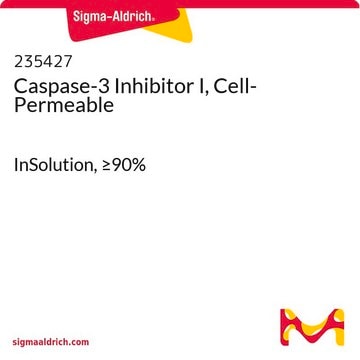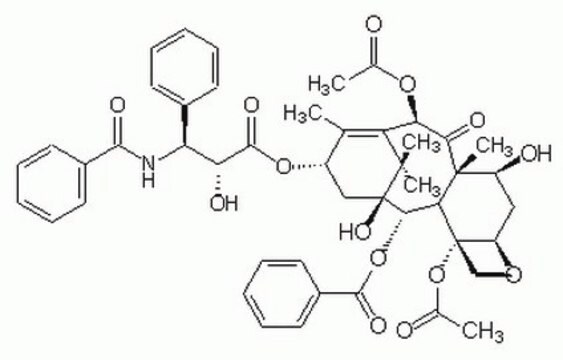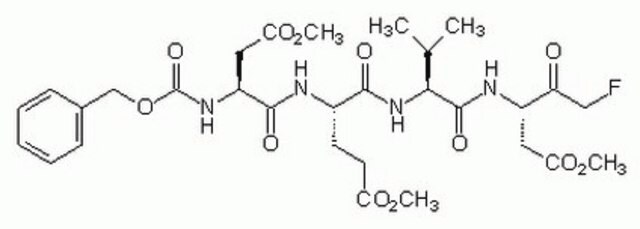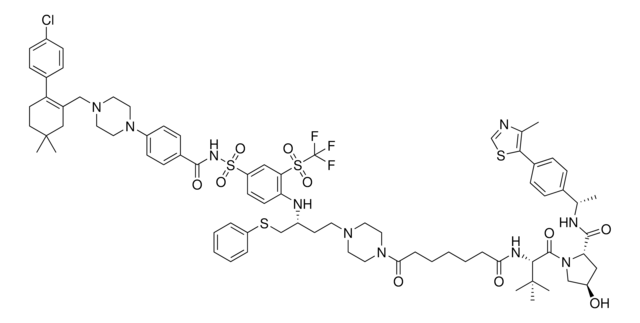235423-M
Caspase-3 Inhibitor I, Cell-Permeable
The Caspase-3 Inhibitor I, Cell-Permeable controls the biological activity of Caspase-3. This small molecule/inhibitor is primarily used for Cancer applications.
Synonym(s):
Caspase-3 Inhibitor I, Cell-Permeable, CPP32/Apopain Inhibitor, Cell-permeable, Cell-permeable, DEVD-CHO
Sign Into View Organizational & Contract Pricing
All Photos(1)
About This Item
Empirical Formula (Hill Notation):
C94H158N20O27
Molecular Weight:
2000.38
UNSPSC Code:
12352200
Recommended Products
Quality Level
Assay
≥97% (HPLC)
form
lyophilized solid
manufacturer/tradename
Calbiochem®
storage condition
OK to freeze
solubility
DMSO: 5 mg/mL
storage temp.
−20°C
General description
A cell-permeable inhibitor of caspase-3, as well as caspase-6, caspase-7, caspase-8, and caspase-10. The C-terminal DEVD-CHO sequence of this peptide is a highly specific, potent, and reversible inhibitor of caspase-3 (Ki<1 nM) that has also been shown to strongly inhibit PARP cleavage in cultured human osteosarcoma cell extracts (IC50 = 200 pM). The N-terminal sequence (amino acid residues 1-16) corresponds to the hydrophobic region (h-region) of the signal peptide of Kaposi fibroblast growth factor (K-FGF) and confers cell-permeability to the peptide. A 5 mM (1 mg/100 l) solution of Caspase-3 Inhibitor I, Cell-permeable in DMSO is also available.
A cell-permeable inhibitor of caspase-3. The C-terminal DEVD-CHO sequence of this peptide is a highly specific, potent and reversible inhibitor of caspase-3 (Ki<1 nM) that has also been shown to strongly inhibit PARP cleavage in cultured human osteosarcoma cell extracts (IC50 = 0.2 nM). The N-terminal sequence (residues 1-16) corresponds to the hydrophobic region (h-region) of the signal peptide of Kaposi fibroblast growth factor (K-FGF) and confers cell-permeability to the peptide.
Biochem/physiol Actions
Primary Target
caspase-3
caspase-3
Target IC50: 200 pM for inhibiting PARP cleavage in cultured human osteosarcoma cell extracts
Warning
Toxicity: Standard Handling (A)
Sequence
Ac-Ala-Ala-Val-Ala-Leu-Leu-Pro-Ala-Val-Leu-Leu-Ala-Leu-Leu-Ala-Pro-Asp-Glu-Val-Asp-CHO
Reconstitution
Following reconstitution, aliquot and freeze (-20°C). Stock solutions are stable for up to 1 month at -20°C.
Other Notes
Thornberry, N.A., and Lazebnik, Y. 1998. Science 281, 1312.
Lin, Y.-Z., et al. 1996. J. Biol. Chem. 271, 5305.
Nicholson, D.W. 1996. Nature Biotechnol. 14, 297.
Schlegel, J., et al. 1996. J. Biol. Chem.271, 1841.
Lin, Y.-Z., et al. 1995. J. Biol. Chem.270, 14255.
Nicholson, D.W., et al. 1995. Nature 376, 37.
Tewari, M., et al. 1995. Cell 81, 801.
Lazebnik, Y.A., et al. 1994. Nature371, 346.
Lin, Y.-Z., et al. 1996. J. Biol. Chem. 271, 5305.
Nicholson, D.W. 1996. Nature Biotechnol. 14, 297.
Schlegel, J., et al. 1996. J. Biol. Chem.271, 1841.
Lin, Y.-Z., et al. 1995. J. Biol. Chem.270, 14255.
Nicholson, D.W., et al. 1995. Nature 376, 37.
Tewari, M., et al. 1995. Cell 81, 801.
Lazebnik, Y.A., et al. 1994. Nature371, 346.
Legal Information
CALBIOCHEM is a registered trademark of Merck KGaA, Darmstadt, Germany
Storage Class Code
11 - Combustible Solids
WGK
WGK 1
Flash Point(F)
Not applicable
Flash Point(C)
Not applicable
Certificates of Analysis (COA)
Search for Certificates of Analysis (COA) by entering the products Lot/Batch Number. Lot and Batch Numbers can be found on a product’s label following the words ‘Lot’ or ‘Batch’.
Already Own This Product?
Find documentation for the products that you have recently purchased in the Document Library.
Our team of scientists has experience in all areas of research including Life Science, Material Science, Chemical Synthesis, Chromatography, Analytical and many others.
Contact Technical Service